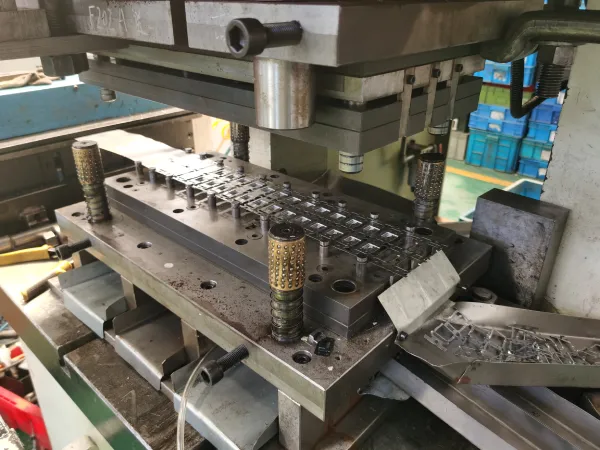Exploring the World of Metal Stamping: From Style to Manufacturing
Within the world of production, steel marking attracts attention as a precise and effective technique for shaping metal sheets into various types with amazing uniformity. From the first style stage where complex patterns materialize to the detailed manufacturing procedures, steel marking is a mix of virtuosity and design. Exploring this world reveals a complicated interplay of imagination and technical mastery, offering a glimpse right into a world where technology fulfills workmanship.
History of Metal Stamping
Metal marking, an extensively utilized manufacturing process today, has a rich background that goes back to ancient times (Metal Stamping). The origins of metal stamping can be mapped to old people such as the Egyptians, who used marking strategies to decorate jewelry and accessories with detailed styles. In time, metal marking progressed, with worlds like the Greeks and Romans utilizing it for producing coins and ornamental items

In the 20th century, steel stamping proceeded to develop with the assimilation of automation and computer mathematical control (CNC) innovation. These innovations additionally increased the performance and precision of metal marking processes, making it an indispensable part of modern-day manufacturing throughout industries such as vehicle, aerospace, and electronic devices. Today, metal marking remains a crucial production process, integrating practice with development to fulfill the demands of a continuously advancing industry.
Style Factors To Consider and Prototyping
When developing metal marking tasks, precise interest to make considerations and prototyping is necessary for making certain optimal manufacturing results. Layout considerations in metal stamping include product option, component geometry, tooling design, and production expediency. Picking the appropriate material is essential as it affects the component's efficiency, price, and manufacturability. Component geometry influences the complexity of the stamping process and the functionality of the last item. Tooling style plays a considerable duty in the success of steel marking projects, impacting component precision, device long life, and manufacturing performance.
Prototyping is an essential visit our website phase in the steel stamping procedure that enables engineers to check the design, confirm manufacturability, and make his response needed adjustments prior to full-scale manufacturing. By carefully taking into consideration style facets and using prototyping, suppliers can improve the steel stamping procedure and achieve high-grade, economical manufacturing results.
Tooling and Tools Essentials
Taking into consideration the crucial duty that tooling design plays in the success of metal marking projects, comprehending the crucial tools and devices required is critical for attaining efficient production end results. Tooling is a fundamental element of steel marking, as it directly affects the top quality and uniformity of the final products. Necessary devices include dies, strikes, and components, which are custom-made to shape and reference develop the metal right into the wanted components. Dies are the primary tool utilized to reduce and create the steel, while punches assist produce openings or details shapes. Fixtures hold the metal in position throughout the marking procedure, making certain precision and repeatability. Additionally, equipment such as stamping presses, feeders, and coil handling systems are important for automating the marking procedure and boosting performance. Spending in top notch tooling and tools not only boosts production effectiveness yet likewise causes greater accuracy, lowered waste, and total price financial savings in steel marking procedures.
Manufacturing Process and Quality Assurance
Successfully managing the manufacturing procedure and executing durable top quality control steps are crucial for guaranteeing the success of steel stamping jobs. The manufacturing process in metal stamping entails a collection of steps that need to be meticulously collaborated to attain optimum results.
Quality control in steel marking is critical to deliver items that satisfy the needed specs. By maintaining stringent top quality control requirements, producers can copyright their track record for providing top notch steel marked items.
Applications and Industry Insights
In the realm of steel stamping, the effective application of production processes and top quality control procedures directly affects the effectiveness and reliability of numerous industry applications and gives useful insights right into the industry's functional dynamics. Steel stamping locates extensive application throughout diverse sectors, including auto, aerospace, electronics, and devices. In the automobile sector, steel marking plays a critical function in generating components such as framework, brackets, and structural components with high precision and performance. The aerospace industry counts on steel stamping for producing intricate parts like panels, braces, and fittings that satisfy rigorous quality requirements (Metal Stamping). In the electronic devices industry, steel marking is used to produce specific components like ports, terminals, and warmth sinks. Additionally, metal stamping promotes the production of various family devices, including refrigerators, washing makers, and stoves, by providing affordable options for making durable and complex parts. Comprehending the applications and sector understandings of steel stamping is important for enhancing manufacturing procedures and improving item top quality throughout various sectors.

Final Thought
Layout considerations, prototyping, tooling, tools, production procedures, and quality control are necessary facets of steel stamping. With its widespread applications and market understandings, steel stamping proceeds to be a functional and reliable manufacturing procedure.
Comments on “Specialist Tips for Choosing the Right Metal Stamping Solutions for Your Demands”